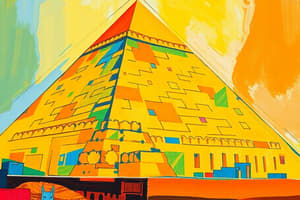Podcast
Questions and Answers
What principle construction method was primarily used in ancient Egyptian architecture?
What principle construction method was primarily used in ancient Egyptian architecture?
- Masonry construction with arches
- Reinforced concrete techniques
- Post and lintel construction (correct)
- Arch and vault construction
Which material was primarily used for domestic buildings in ancient Egypt?
Which material was primarily used for domestic buildings in ancient Egypt?
- Wood
- Mud brick (correct)
- Sun-dried clay
- Stone
What does the term 'battered walls' refer to in Egyptian architecture?
What does the term 'battered walls' refer to in Egyptian architecture?
- Walls that slope backward as they rise (correct)
- Walls with intricate carvings
- Walls made from sandstone
- Walls adorned with hieroglyphics
What is the significance of hieroglyphics in ancient Egyptian architecture?
What is the significance of hieroglyphics in ancient Egyptian architecture?
What environmental factor greatly influenced the architectural style of ancient Egypt?
What environmental factor greatly influenced the architectural style of ancient Egypt?
Which of the following Egyptian gods is considered the chief god?
Which of the following Egyptian gods is considered the chief god?
What is the primary purpose of axial planning in ancient Egyptian architecture?
What is the primary purpose of axial planning in ancient Egyptian architecture?
What does the term 'Black Land' refer to in the context of ancient Egypt?
What does the term 'Black Land' refer to in the context of ancient Egypt?
What does the Eye of Horus symbolize?
What does the Eye of Horus symbolize?
Which symbol is clutched by gods and often given to the queen?
Which symbol is clutched by gods and often given to the queen?
What does the Feather of Ma'at represent?
What does the Feather of Ma'at represent?
Which symbol is associated with royalty and is often represented in funerary contexts in Ancient Egypt?
Which symbol is associated with royalty and is often represented in funerary contexts in Ancient Egypt?
What does the symbol of the Scarab signify?
What does the symbol of the Scarab signify?
Which of the following represents the Sun and its life-giving powers in Ancient Egyptian culture?
Which of the following represents the Sun and its life-giving powers in Ancient Egyptian culture?
Who is credited with the design of the Step Pyramid of Djoser?
Who is credited with the design of the Step Pyramid of Djoser?
What is the role of the Cartouche in Ancient Egyptian culture?
What is the role of the Cartouche in Ancient Egyptian culture?
Flashcards are hidden until you start studying
Study Notes
Architectural Character
- Emphasizes simplicity, monumentality, and massiveness in design and structure.
Geography of Egypt
- Located in northeast Africa, characterized as a desert land known as the 'Land of Pharaohs'.
- The Nile River is referred to as the lifeblood of Egypt.
- Distinction between Black Land (fertile soil along the Nile) and Red Land (barren desert).
Geological Aspects
- Construction principle is based on post and lintel techniques.
- Domestic buildings primarily use mud bricks; temples and pyramids are primarily constructed from stone.
- Additional materials include sun-dried bricks, palm leaves (roofing), acacia (boats), and sycamore (mummy cases).
Construction Techniques
- Axial planning organizes buildings longitudinally, highlighting hierarchical importance.
- Trabeated construction utilizes post and lintel frameworks with flat roofs supported by walls and closely spaced columns.
- Battered walls feature a backward slope as they rise.
- Hieroglyphs and pictorial frescoes adorn walls and columns, serving decorative and historical purposes while depicting the Ancient Egyptians' beliefs and lifestyles.
Climate Influences
- The dry and hot climate results in simple designs, minimal windows, and massive walls suitable for hieroglyphics.
- Buildings often have flat roofs due to lack of rainfall, eliminating the need for drainage systems.
Religious Context
- Ancient Egyptians held a strong belief in eternity and the afterlife, influencing their architecture and art.
- The Theban Triad consists of Amun-Ra (chief god), Mut (queen of the gods), and Khonsu (god of moon and time).
Royal Symbols
- Pschent represents kingship of Upper (Hedjet) and Lower Egypt (Deshet).
- Nemes crown is a striped headdress traditionally worn by the king.
- Ankh symbolizes life, health, and strength, often depicted in association with gods.
- Feather of Ma'at represents justice and morality; a deceased's heart is weighed against it.
- Eye of Horus symbolizes protection and royal power.
- Cartouche serves as an enclosure for royal names for protective purposes.
- Other symbols such as the Was scepter (power), scarab (resurrection), and uraeus (royal protection) were prominent.
Important Personalities and Structures
- Imhotep, the architect of the Step Pyramid of Djoser, is a pivotal figure in Egyptian architecture.
- Mentuhotep II is noted for developing the rock-cut tomb.
- Senusret I is credited with erecting the earliest known obelisk at Heliopolis.
- Amenemhat I built the Great Temple of Amun at Karnak, hailed as one of the greatest Egyptian temples.
Studying That Suits You
Use AI to generate personalized quizzes and flashcards to suit your learning preferences.




